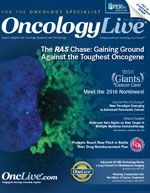Publication
Article
Oncology Live®
RAS Researcher Looks Forward With Optimism
Author(s):
Perry Kennedy, PhD, discusses the goals of the RAS Initiative.
Perry Kennedy, PhD
When it comes to research into RAS mutations, the stakes are high for patients with pancreatic cancer. About 95% of pancreatic tumors harbor mutations in KRAS, one of the RAS family genes.
As a result, the Pancreatic Cancer Action Network (PanCan) helps fund research into RAS mutations being conducted through the leadership of the National Cancer Institute’s Frederick National Laboratory for Cancer Research. This support for the RAS Initiative includes postdoctoral research fellowships and travel scholarships.
OncLive: Please put the RAS Initiative into context.
Perry Kennedy, PhD, of Moffitt Cancer Center in Florida, has been awarded a PanCan postdoctoral research fellowship to explore KRAS mutations. Kennedy, who said he appreciates the support of PanCan and the Frederick lab, discussed the goals of the RAS Initiative in an interview with OncLive.Kennedy: Ever since the RAS genes were discovered in human tumors around the 1980s, scientists have found out there’s a high degree of RAS mutation in a number of cancers. RAS is mutated in 20% to 30% of all human cancers.
What are the challenges of this research?
How is the RAS Initiative tackling these challenges?
So attacking this is really a pinnacle. If we were able to shut down the activity of RAS, we would shut down a number of those downstream signaling pathways and thereby shut down many of the things that contribute to cancer.RAS initially was called undruggable. Traditionally, when you try to attack something with a drug, you use a small molecule that can hopefully bind in a certain binding pocket to inhibit the activity of that enzyme. But, for RAS, it appears to have very shallow binding pockets so there’s no good tractable place to attack it from.The RAS Initiative is drawing together a lot of people who are attacking RAS from different angles. They’re trying to understand more about how it behaves in its aberrant form—as the mutated form— and attack it in more intelligent ways.
What developments are on the horizon that would make RAS targetable?
What is your research project?
I think they’re really gaining traction now, which is causing people to jump on board and get more excited about this—that we can no longer think this is undruggable.I think understanding more about its structure. Part of the initiative involves looking at its 3-D structure so they can model how RAS is folded in its native protein structure even with the mutations. Now they’re going forward to try to analyze its structure when it’s bound to its effectors to cause signaling effects.We’ve set up sort of a pathway for inhibitor screening. We have at our disposal several libraries of chemical small molecules and we have planned out a process to interrogate and screen through these libraries.
First, we’d like to screen for compounds that bind to KRAS and from those hits, we can then interrogate to determine whether there is functional inhibition. We plan to evaluate whether the possible hits can block the binding of GTP [guanosine triphosphate] to RAS. GTP binding to RAS is necessary for its activation and further downstream signaling, so that’s one approach.
The other approach is on the flip side—actually preventing RAS interaction with its effectors such as RAF.
We’ve set up assays in our lab to evaluate that and once we can find hits from those assays, we can then co-crystallize our compound with a mutant form of RAS to see where it did bind.
From there, we can do chemical optimization to produce better compounds that are more selective and more potent. I think the challenge right now is increasing compound affinity in its binding for RAS.










